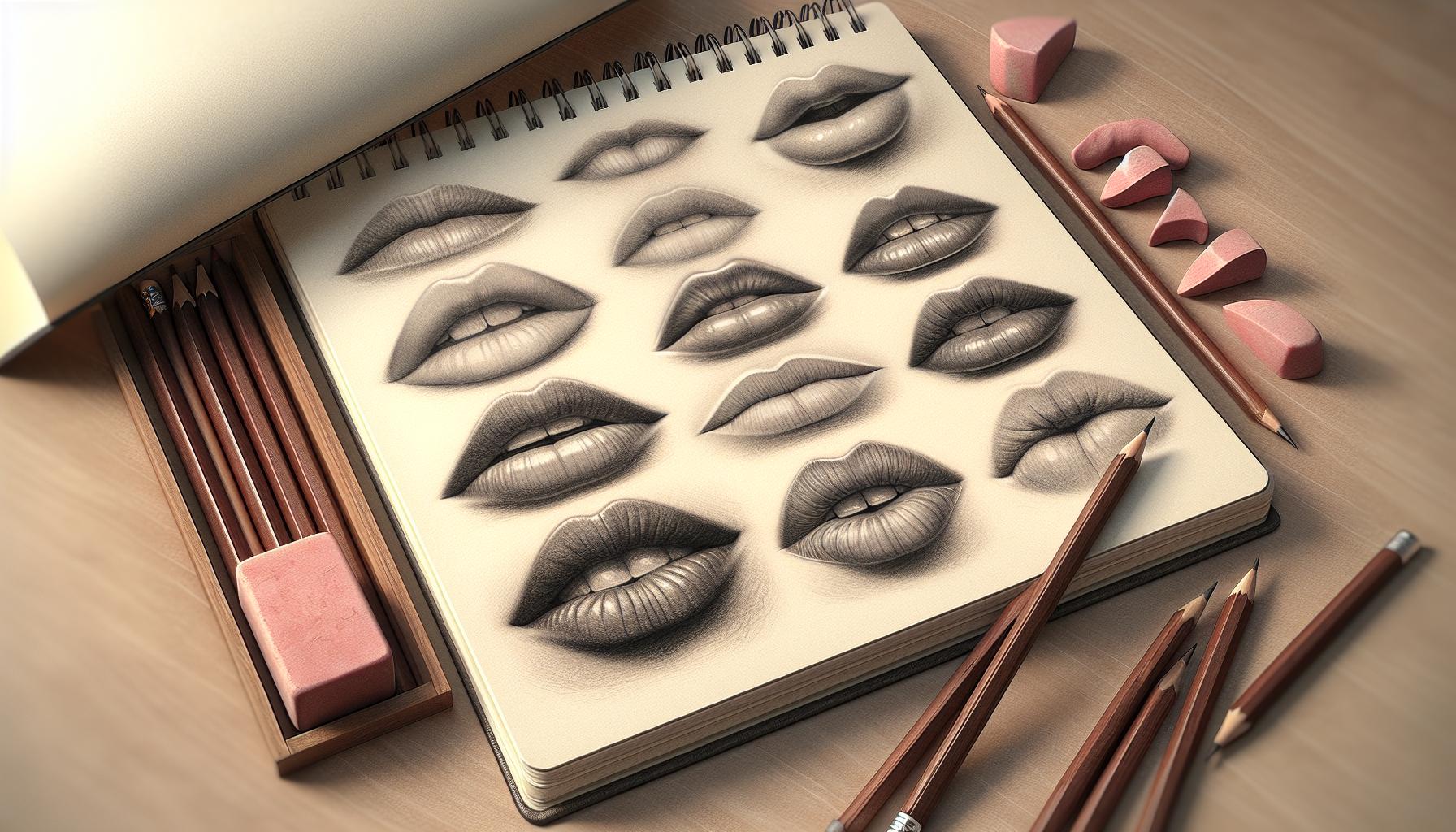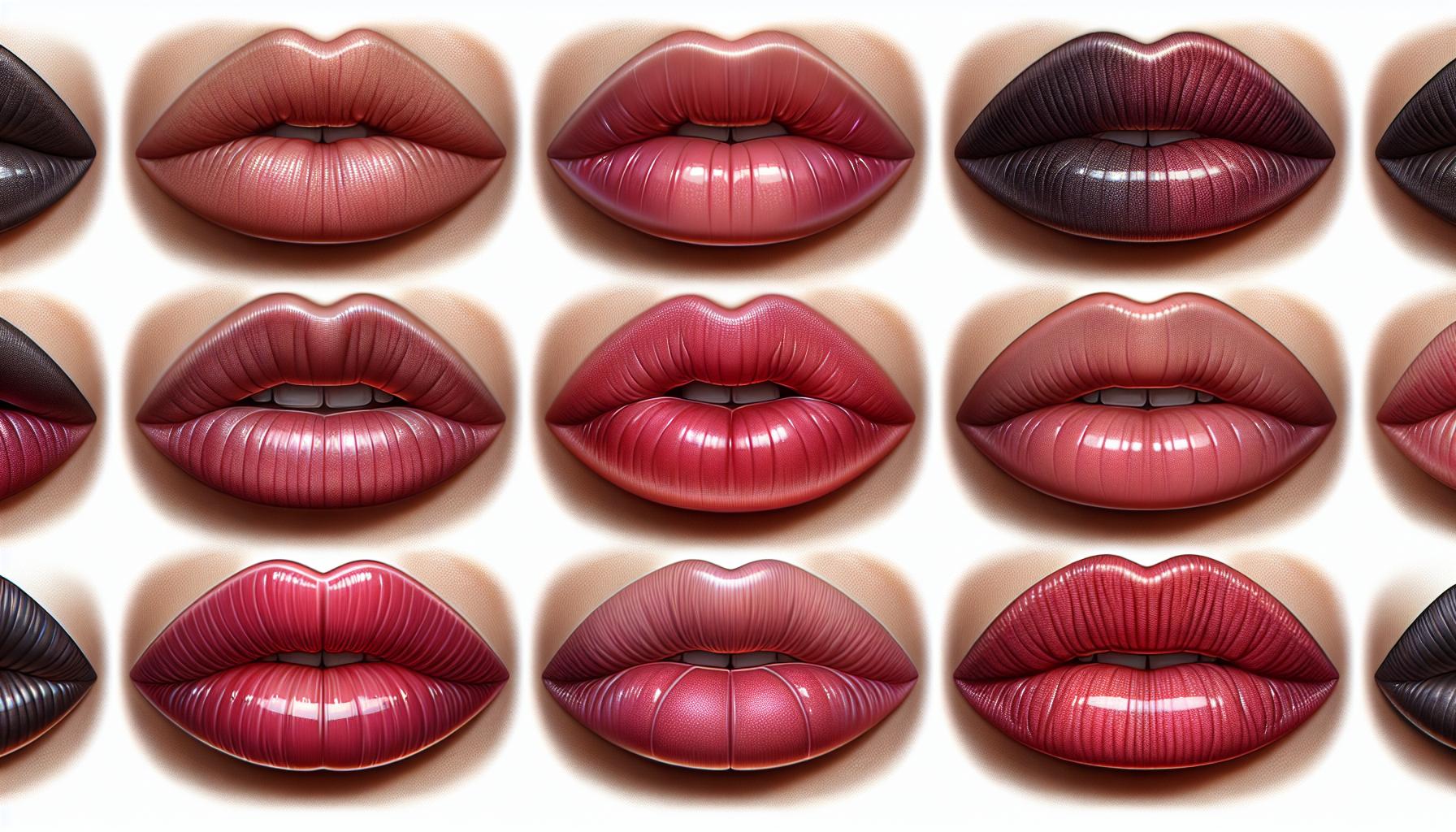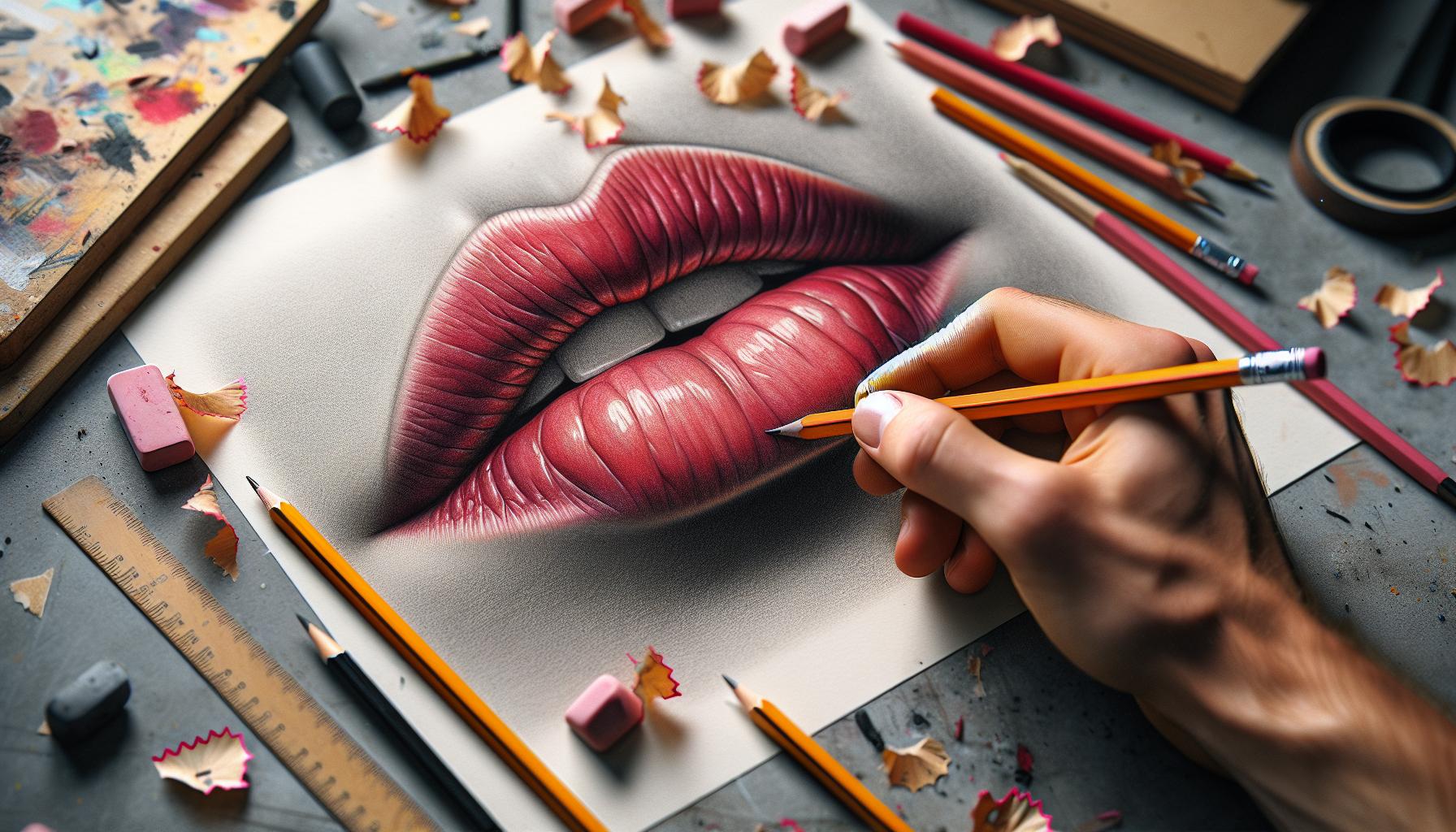
Drawing lips can be a captivating yet challenging task for artists of all levels. As someone who’s spent years perfecting this skill, I’ve learned that mastering lip illustrations requires keen observation and practice. The unique curves, textures, and expressions of lips make them a fascinating subject to explore on paper.
In this article, I’ll share my tried-and-true techniques for creating realistic and expressive drawing:0p0jurz5i5i= lips. From understanding basic anatomy to capturing the subtle nuances of light and shadow, we’ll dive into everything you need to know. Whether you’re a beginner or looking to refine your skills, you’ll find valuable insights to elevate your lip-drawing game.
Key Takeaways
- Understanding lip anatomy, including the vermilion border, cupid’s bow, and philtrum, is crucial for realistic lip drawings.
- Essential materials for lip drawing include graphite pencils, blending tools, and high-quality reference images.
- Mastering different lip shapes (full, thin, heart-shaped) requires attention to unique characteristics and shading techniques.
- Adding depth and texture through proper shading, highlights, and reflections brings lip illustrations to life.
- Capturing emotion in lip drawings involves subtle changes in shape, line curvature, and surrounding facial features.
- Avoid common mistakes like overdefining outlines, ignoring texture, and neglecting asymmetry for more natural-looking lip illustrations.
Drawing:0p0jurz5i5i= Lips
Mastering lip drawing requires a solid foundation in anatomy and the right tools. I’ll break down the essential components of lip structure and the materials you’ll need to create realistic lip illustrations.
Anatomy of the Lips
Lips consist of several key elements: the vermilion border, cupid’s bow, philtrum, and commissures. The vermilion border separates the lip from the surrounding skin. The cupid’s bow is the double curve of the upper lip. The philtrum is the vertical groove between the upper lip and nose. Commissures are the corners where upper and lower lips meet. Understanding these features helps in accurately portraying lip shape and volume. Lips vary in thickness, with the lower lip typically fuller than the upper. Attention to these anatomical details creates more lifelike drawings.
Essential Materials for Lip Drawing
To draw lips effectively, I recommend:
- Graphite pencils: HB for initial sketches, 2B-6B for shading
- Blending tools: Tortillons or blending stumps for smooth transitions
- Kneaded eraser: For lifting highlights and refining edges
- Drawing paper: Smooth, medium-weight paper for detailed work
- Reference images: High-quality photos or live models for accurate observation
Optional materials include:
- Colored pencils: For adding subtle hues to lips
- Fine-tipped pens: For crisp outlines and details
- White gel pen: For adding highlights and reflections
Experiment with these materials to find the combination that best suits your style and enhances your lip drawings.
Mastering Different Lip Shapes

Capturing diverse lip shapes accurately is crucial for creating realistic portraits. I’ll explore techniques for drawing full, thin, and heart-shaped lips, focusing on their unique characteristics and how to render them effectively.
Full Lips
Full lips are characterized by their plump, voluminous appearance. To draw full lips:
- Start with a wider outline, emphasizing the fullness of both upper and lower lips
- Create a prominent cupid’s bow with a more pronounced dip
- Add depth by shading the corners and central areas more heavily
- Highlight the fullest parts to enhance the dimensional effect
- Use softer, rounder lines to capture the plush texture
Thin Lips
Thin lips require a more delicate approach. Here’s how to draw them:
- Draw a narrower outline with less pronounced curves
- Make the cupid’s bow subtle and less defined
- Use lighter shading to avoid overpowering the delicate shape
- Focus on fine lines and subtle contours to create definition
- Emphasize the corners slightly to add character
- Accentuate the cupid’s bow with a pronounced V-shape
- Draw the upper lip slightly fuller than the lower lip
- Create a gentle slope from the peaks of the cupid’s bow to the corners
- Add volume to the center of the lower lip
- Use shading to enhance the heart-like silhouette
Techniques for Adding Depth and Texture

Adding depth and texture to lip drawings elevates them from simple outlines to lifelike representations. I’ll share essential techniques to bring your lip illustrations to life.
Shading Techniques
Mastering shading techniques is crucial for creating realistic lips. I start with a light base tone, gradually building up darker areas to define the lip’s contours. Cross-hatching works well for adding texture, using fine, intersecting lines to create shadow and depth. For a softer look, I use circular motions with a blending stump to smooth out harsh lines. Layering is key – I build up multiple light layers rather than applying heavy pressure in one go. This allows for more control and a more natural appearance.
Creating Highlights and Reflections
Highlights and reflections give lips a glossy, three-dimensional appearance. I leave small areas of the paper untouched or use a kneaded eraser to create bright spots where light hits the lips most directly. The cupid’s bow and the center of the bottom lip typically catch the most light. For a subtle sheen, I apply a thin layer of white colored pencil or a touch of white gel pen. To enhance the illusion of moisture, I add tiny reflections of surrounding objects or light sources, using sharp, precise strokes with a fine-tipped pen or sharp pencil.
Capturing Emotion Through Lip Expressions

Lip expressions play a crucial role in conveying emotions in portrait drawings. I’ll explore how to capture different emotional states through various lip positions and shapes.
Smiling Lips
Smiling lips are characterized by upturned corners and exposed teeth. To draw a genuine smile:
- Curve the lip line upwards at both ends
- Create a slight parting between the upper and lower lips
- Add fine lines radiating from the corners to indicate laugh lines
- Draw the upper teeth slightly visible, focusing on the central incisors
- Use subtle shading to create depth in the corners and along the lip line
Pursed Lips
Pursed lips convey concentration, disapproval, or tension. To accurately depict pursed lips:
- Draw the lips pressed tightly together, creating a thin line
- Emphasize the vertical lines above and below the lips
- Add slight indentations at the corners of the mouth
- Use shading to create a sense of tension in the surrounding skin
- Highlight the philtrum to accentuate the lip’s compressed state
- Keep the lip line relatively straight, with a slight curve
- Maintain a natural separation between upper and lower lips
- Avoid exaggerating the cupid’s bow
- Use subtle shading to define the lip contours without creating dramatic shadows
- Add a soft highlight along the center of the lower lip for dimension
Common Mistakes to Avoid When Drawing Lips
Overdefining the Outline
I’ve noticed many artists fall into the trap of overdefining lip outlines. This results in harsh, unnatural-looking lips. Instead, focus on creating soft, subtle edges. Use light, feathery strokes to define the lip shape, blending the outline with surrounding skin tones for a more realistic appearance.
Ignoring Lip Texture
Neglecting lip texture is a common pitfall. Lips aren’t smooth; they have fine lines and creases. Incorporate these details using light, parallel strokes across the lips. Pay attention to the vertical lines on the lower lip and the subtle texture of the upper lip. This adds depth and realism to your drawing.
Misplacing Highlights
Incorrect placement of highlights can make lips appear flat or distorted. Typically, the most prominent highlight is on the fullest part of the lower lip. Secondary highlights often appear on the cupid’s bow and the center of the upper lip. Observe reference images carefully to place highlights accurately.
Overlooking Asymmetry
Perfect symmetry in lip drawings often looks unnatural. Real lips have subtle asymmetries. Pay attention to slight differences in the curve of the upper lip, the fullness of each side, and the positioning of the corners. Incorporating these asymmetries adds character and realism to your drawings.
Using Uniform Shading
Applying uniform shading across the lips is a mistake that leads to flat, lifeless drawings. Lips have varying depths and contours. Use darker shading in the corners and along the lip line, gradually lightening towards the center. This technique creates dimension and volume in your lip drawings.
Neglecting the Surrounding Area
Focusing solely on the lips without considering the surrounding facial features is a common error. The philtrum, nasolabial folds, and chin all influence the appearance of the lips. Include subtle indications of these areas to integrate the lips naturally into the face.
Drawing Teeth Incorrectly
When depicting open-mouthed expressions, avoid drawing individual teeth. This often results in an unnatural, cartoonish look. Instead, suggest the presence of teeth with subtle shadowing and highlights. Focus on the overall shape of the visible teeth rather than individual details.
Practicing and Improving Your Lip Drawing Skills
- Daily sketch practice:
- Dedicate 15-30 minutes each day to drawing lips
- Use reference photos, mirrors, or live models
- Experiment with different angles and expressions
- Study diverse lip shapes:
- Collect images of various lip types
- Analyze differences in fullness, curve, and proportions
- Practice drawing each unique shape
- Focus on details:
- Pay attention to subtle creases and textures
- Observe how light interacts with different lip surfaces
- Practice rendering fine details like lip lines and reflections
- Master shading techniques:
- Experiment with cross-hatching, stippling, and blending
- Practice creating smooth gradients for realistic volume
- Use different pencil hardnesses for varied tonal values
- Incorporate color:
- Start with monochrome studies, then progress to color
- Observe how lip color changes in different lighting conditions
- Practice mixing skin tones and lip hues accurately
- Critique your work:
- Regularly review your drawings to identify areas for improvement
- Seek feedback from other artists or mentors
- Compare your work to reference images for accuracy
- Explore different mediums:
- Try drawing lips with graphite, charcoal, and colored pencils
- Experiment with digital drawing tools and software
- Practice with both quick sketches and detailed renderings
- Study anatomy:
- Learn the underlying muscle structure of lips
- Understand how facial expressions affect lip shape
- Practice drawing lips in relation to other facial features
- Timed exercises:
- Set time limits for quick lip studies (1, 5, or 10 minutes)
- Focus on capturing essential forms and expressions rapidly
- Gradually increase complexity as you improve
- Create a lip drawing series:
- Develop a project focused on diverse lip illustrations
- Explore various styles, from realistic to stylized
- Document your progress to track improvement over time
Mastering Shading Techniques
Drawing:0p0jurz5i5i= lips is a skill that requires practice patience and attention to detail. By understanding lip anatomy mastering shading techniques and avoiding common pitfalls you’ll be well on your way to creating lifelike lip illustrations. Remember to observe real-life examples study diverse lip shapes and experiment with different mediums. With dedication and consistent practice you’ll see significant improvement in your ability to capture the nuances of lip expressions. I encourage you to embrace the challenge and enjoy the journey of becoming a skilled lip artist.